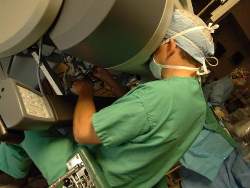The Gibbs Cancer Center, a division of the Spartanburg Regional Healthcare System, has the credit of being the first to use the da Vinci Surgical System, which is a robotic device for performing minimally invasive surgeries for the removal of cancerous tumors from the lungs in the South Carolina region.
 Da Vinci system
Da Vinci system
Christophe Nguyen, practicing as an oncologist at the Cancer Center in South Carolina was the first surgeon to use the robotic procedure, which would noticeably decrease the recovery times and pain levels for the patients. This technique has already been tried in a few other states and has been attracting the attention of the surgeons from all over the state. Nguyen had previously performed using the total port access and robot assisted thoracoscopic lobectomy, a minimally invasive thoracic surgery. In this procedure, access is gained to the tumor via many small incisions between the ribs, and then the tumor is removed by expanding one of the incisions. The incisions are done by the robotic arms, which Nguyen controls sitting on a console by video imaging. This is totally different from the traditional open surgery where muscles need to be cut or broken or the ribs need to be split.
Nguyen has performed the new surgical procedure on the lungs six times and 25 times on the thoracic region. According to him, a few others have tried this surgery in the state but have not been able to complete it. He found to his amazement that the recovery times were very less for the patients and that they also experienced less pain. But this procedure has a disadvantage as the precision offered by open techniques is not found here. However, the robotic equipment offers high mobility inside the body to offset the disadvantages posed. Patients have to be carefully chosen for the procedure. Only stage I or stage II lung cancer patients with small sized tumors could be selected as the size of the tumors would reduce the length of incisions for removal of the tumors. The cost factor is not a consideration, as it is the same as that for the open technique. Nguyen is to speak in Columbia in two symposiums about this technique in the future, and other doctors from Low country are planning to come to Spartanburg to observe and learn this new robotic technique.